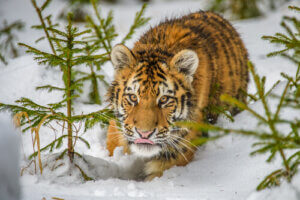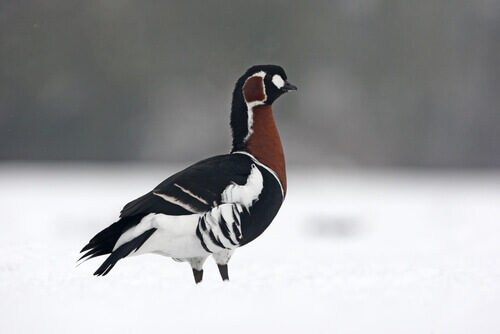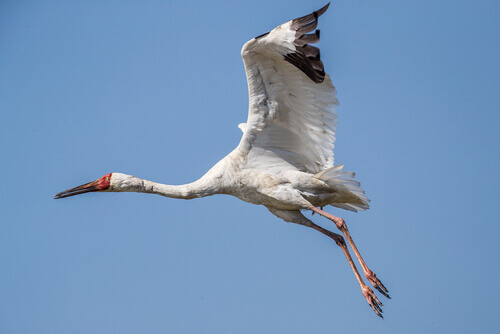All About the Siberian Fauna

Perhaps we find it a little strange that in such a hostile region, where temperatures go well below 0°C (32°F), life can exist. However, the Siberian fauna is quite vast, and most species found here are the wild “versions” of their species.
The make of Siberian fauna
It’s good to understand the geographical context a little before moving on to talk about the Siberian fauna. So, this large region of Northern Asia stretches from the Ural Mountains to the Pacific Ocean and from the Arctic Ocean to China, Mongolia and Kazakhstan. Consequently, Siberia makes up more than half of the Russian territory.
Not many people live on these latitudes due to its adverse climate: temperatures can reach -20°C (-4°F) in winter, and summer lasts only a month. Here, we can only find scattered villages with few inhabitants.
As for the Siberian fauna, it’s made up of more species than we think. The bad news is that many of these animals are in danger of extinction due to the destruction of their natural habitat and indiscriminate hunting.
1. Siberian Tiger
Also known as ‘Amur tiger‘, this carnivore –see the photo at the beginning of this article– lives in woodland areas on the border between Russia and China. It’s the largest of felines –it can reach up to 200 kilos (441 lb) and measure 2 meters (7 ft) in length. Furthermore, it’s characterized by its beautiful and remarkable coat, which helps it camouflage in the vegetation.
In the cold months, its fur is thicker and denser, so the snow doesn’t stop it. It even engages in hunts where its paws go several inches deep in the snow, feeding on ungulates such as moose and deer.
2. Red-breasted goose
Believe it or not, several birds are part of the Siberian fauna. One of them is the red-breasted goose which inhabits the forests and tundra of this region, very close to the Khatanga River and on the slopes of ravines and coasts.

These birds migrate to northern Iran and Iraq for a few weeks during winter. However, they spend most of their lives in Siberia, where they form colonies of monogamous pairs.
3. Tundra wolf
This magnificent carnivore, belonging to the Canis lupus family, lives in the tundra and wooded areas of northern Russia. However, it can also be seen in Scandinavia. The tundra wolf is large –about 50 kilos (110 lb) and 140 centimeters (5 ft) in length– and has a thick fur of whitish color in winter, and more grayish or brown in summer.

They form groups of up to 10 members, sleep in burrows all together and don’t usually spend large periods of time in the same place. They travel up to 300 kilometers (186 mi) per year in search of better places, and following the migration of the reindeer, which is their main source of food.
4. Siberian crane
This species of birds belonging to the order Gruiformes, lives both in western Siberia and in the Arctic zone. This bird can migrate long distances, and hibernates near the Yangtze River (China), the Keoladeo National Park (India) or in the Isfahan region (Iran).

It feeds on roots, sprouts, tubers and aquatic plants from the wetlands. Also, the banks of these lowland areas serve as a nest for them to reproduce. The Siberian crane is white, with long legs and a neck of about 140 centimeters (5 ft).
5. Snow sheep: an agile ruminant of the Siberian fauna
It inhabits the northeastern region of Siberia –between the Putorana Mountains and the coast– and is one of the typical representatives of the fauna of these places. Moreover, all subspecies of the family live in this area.

One of its main traits are the antlers that both genders of the species have. These are larger in males, with a curved backward shape. Their coat is dark brown with white markings. Lastly, they have fine athletic legs that allow them to navigate the surroundings without problems.
Perhaps we find it a little strange that in such a hostile region, where temperatures go well below 0°C (32°F), life can exist. However, the Siberian fauna is quite vast, and most species found here are the wild “versions” of their species.
The make of Siberian fauna
It’s good to understand the geographical context a little before moving on to talk about the Siberian fauna. So, this large region of Northern Asia stretches from the Ural Mountains to the Pacific Ocean and from the Arctic Ocean to China, Mongolia and Kazakhstan. Consequently, Siberia makes up more than half of the Russian territory.
Not many people live on these latitudes due to its adverse climate: temperatures can reach -20°C (-4°F) in winter, and summer lasts only a month. Here, we can only find scattered villages with few inhabitants.
As for the Siberian fauna, it’s made up of more species than we think. The bad news is that many of these animals are in danger of extinction due to the destruction of their natural habitat and indiscriminate hunting.
1. Siberian Tiger
Also known as ‘Amur tiger‘, this carnivore –see the photo at the beginning of this article– lives in woodland areas on the border between Russia and China. It’s the largest of felines –it can reach up to 200 kilos (441 lb) and measure 2 meters (7 ft) in length. Furthermore, it’s characterized by its beautiful and remarkable coat, which helps it camouflage in the vegetation.
In the cold months, its fur is thicker and denser, so the snow doesn’t stop it. It even engages in hunts where its paws go several inches deep in the snow, feeding on ungulates such as moose and deer.
2. Red-breasted goose
Believe it or not, several birds are part of the Siberian fauna. One of them is the red-breasted goose which inhabits the forests and tundra of this region, very close to the Khatanga River and on the slopes of ravines and coasts.

These birds migrate to northern Iran and Iraq for a few weeks during winter. However, they spend most of their lives in Siberia, where they form colonies of monogamous pairs.
3. Tundra wolf
This magnificent carnivore, belonging to the Canis lupus family, lives in the tundra and wooded areas of northern Russia. However, it can also be seen in Scandinavia. The tundra wolf is large –about 50 kilos (110 lb) and 140 centimeters (5 ft) in length– and has a thick fur of whitish color in winter, and more grayish or brown in summer.

They form groups of up to 10 members, sleep in burrows all together and don’t usually spend large periods of time in the same place. They travel up to 300 kilometers (186 mi) per year in search of better places, and following the migration of the reindeer, which is their main source of food.
4. Siberian crane
This species of birds belonging to the order Gruiformes, lives both in western Siberia and in the Arctic zone. This bird can migrate long distances, and hibernates near the Yangtze River (China), the Keoladeo National Park (India) or in the Isfahan region (Iran).

It feeds on roots, sprouts, tubers and aquatic plants from the wetlands. Also, the banks of these lowland areas serve as a nest for them to reproduce. The Siberian crane is white, with long legs and a neck of about 140 centimeters (5 ft).
5. Snow sheep: an agile ruminant of the Siberian fauna
It inhabits the northeastern region of Siberia –between the Putorana Mountains and the coast– and is one of the typical representatives of the fauna of these places. Moreover, all subspecies of the family live in this area.

One of its main traits are the antlers that both genders of the species have. These are larger in males, with a curved backward shape. Their coat is dark brown with white markings. Lastly, they have fine athletic legs that allow them to navigate the surroundings without problems.
This text is provided for informational purposes only and does not replace consultation with a professional. If in doubt, consult your specialist.








